Introduction
- The smaller computer chips get, the more information we can store on them.
- Utopian technology is considered to be the future (Ross 52).
- Hyperloop is expected to change the way we view transportation.
- This technology is designed to revolutionise both public and cargo transportation.
- Conventional means of transportation are rather expensive and not as eco-friendly as Hyperloop.
- It is vital to support mass transit and switch to eco-friendly transportation options (Vance).
- The most essential part of the Hyperloop technology is solar panels which can be located on the roof of the Hyperloop train.
Today, we are witnessing an incredible number of technological advancements. The information revolution is real, and we can see it transpire on a global scale. It may even seem that the smaller computer chips get, the more information we can store on them. For the majority of people, such innovations seem like utopian technology, and many of us rightfully consider these advancements to be the future (Ross 52). Unfortunately, however, one of the areas of our lives that has not changed much over the years is the transportation sector. The streets are still overcrowded by cars, and numerous airplanes plough the airspace above us.
Nonetheless, the concept of a relatively new technology named Hyperloop is expected to change the way we view transportation. It is not a jetpack or a teleporter but rather a sort of high-speed train. This technology is designed to revolutionise public and cargo transportation by reducing travel times and providing an eco-friendly solution to transport.
The fact is that conventional means of transportation ultimately turn out to be rather expensive and not as eco-friendly as Hyperloop. Cars, for instance, are not ideal due to their uncontrollable gas emissions and their dependency on unstable fuel sources and prices. It is a well-known fact that the current trends in energy consumption put the transportation industry at a disadvantage. Therefore, it is vital to support mass transit and encourage the public to switch to eco-friendly transportation options (Vance). If we take rail transportation into consideration, we will see that this means of transportation is too slow and also relatively expensive. The key objective of the developers of Hyperloop is to come up with a cost-effective solution to the existing issues in transportation and make mid-distance travel available to everyone. The most essential part of the Hyperloop technology is solar panels which can be located on the roof of the Hyperloop train.
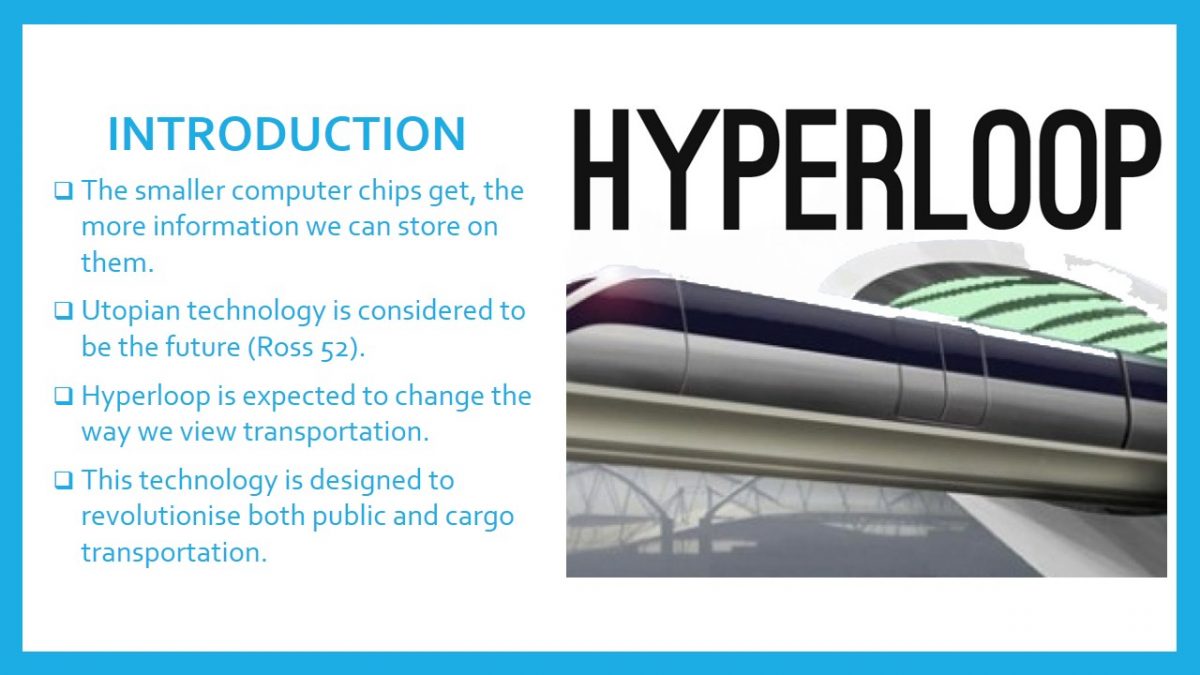
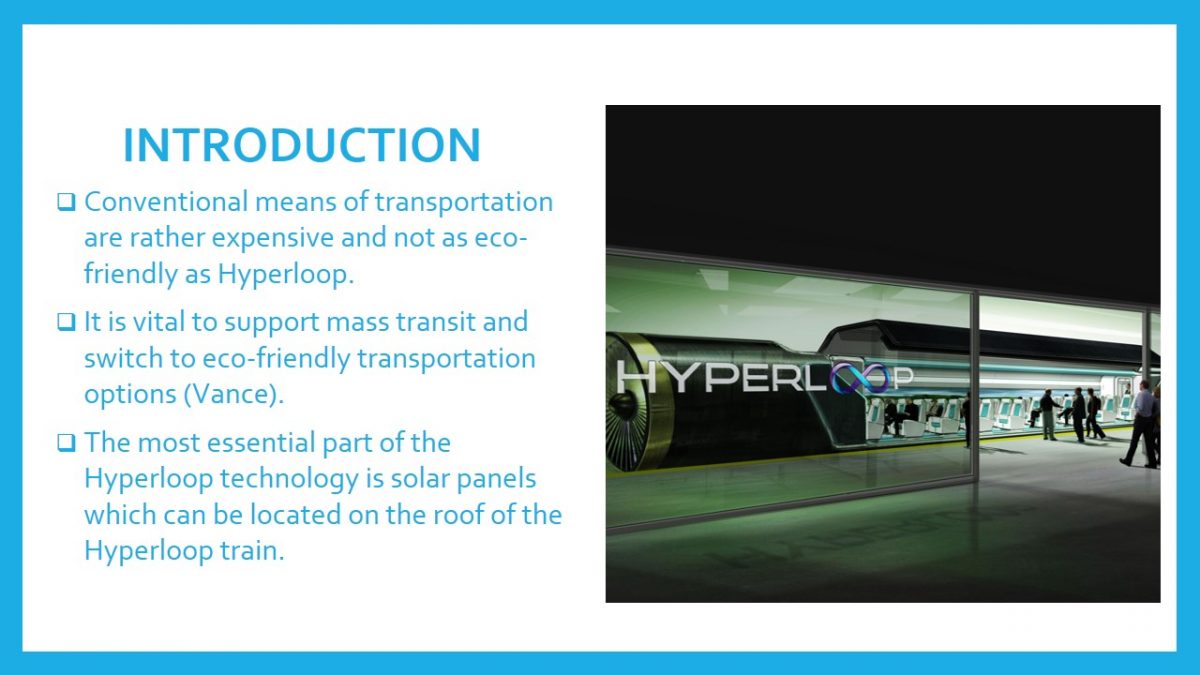
Advantage
Speed
- Hyperloop technology allows for the transportation of people through special tubes at a rather high speed (500 miles per hour).
- For comparison, the relatively outdated bullet train technology is able to reach a speed of not more than 150 miles per hour.
One of the key advantages of Hyperloop technology is that it allows for the transportation of people through special tubes at a rather high speed. Transport is done by means of pods which move in vacuum-sealed tubes and are able to reach speeds of not less than 500 miles per hour. By this method, a trip from, for instance, Los Angeles to San Francisco would only take approximately 30 minutes. For comparison’s sake, the relatively outdated bullet train technology is able to reach a speed of not more than 150 miles per hour. While a trip from Las Vegas to Los Angeles by bullet train would only take 80 minutes, a similar trip from Los Angeles to San Francisco by bullet train would take seven hours on average. When compared to the Hyperloop’s 30 minutes, it is clear that the existing bullet train technology is really not that impressive.
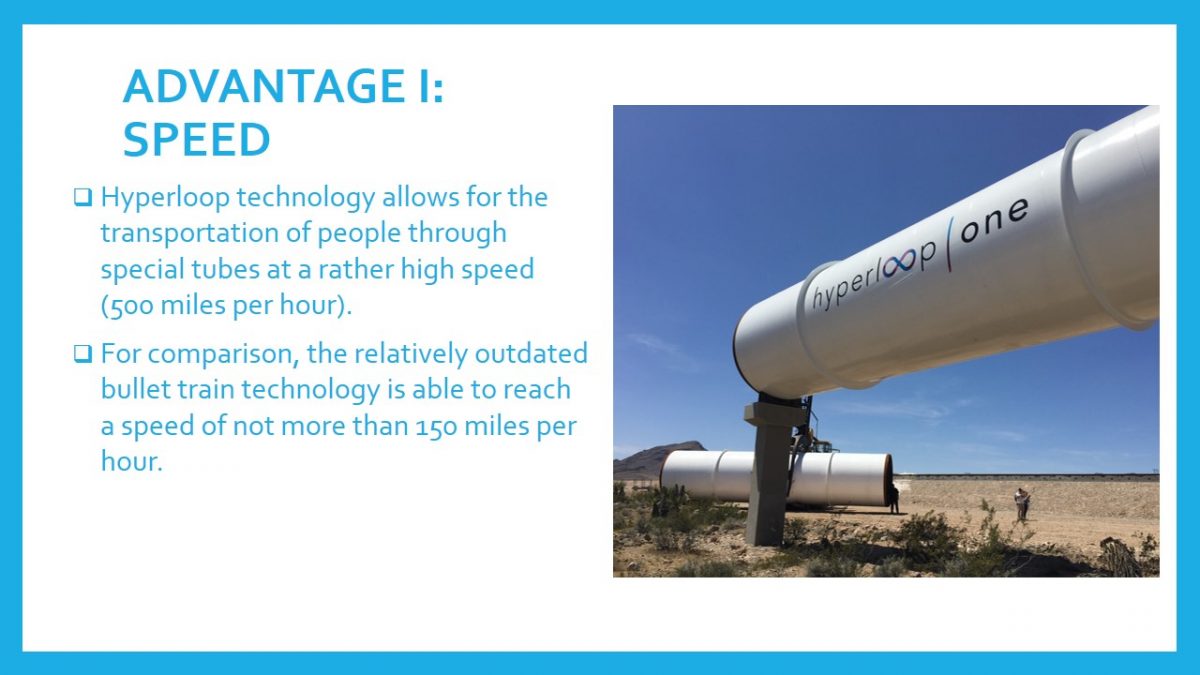
Price
- The trip from Los Angeles to San Francisco will only cost $30 each way (or $60 for a round trip).
- The fact is that Hyperloop is both cheaper and faster than planes and passenger trains.
The second advantage of the Hyperloop technology is its relatively affordable price. For instance, the trip from Los Angeles to San Francisco mentioned previously would only cost $30 each way (or $60 for a round trip). A round trip from Las Vegas to Los Angeles would cost $90. Travelling by plane, by comparison, would have you spending approximately 70 minutes in the air along with a ticket cost of $75 to $160. Even if train tickets were pricier, one reason to take the train instead of boarding a plane would be the ability to avoid the time-consuming security checks that take place at the airport.
Ultimately, the fact is that Hyperloop is both cheaper and faster than planes and passenger trains. One may consider the traveling distance when comparing the available means of transportation; with Hyperloop, you would get 760 miles for $60, and with a bullet train, one only gets 460 miles for $90.
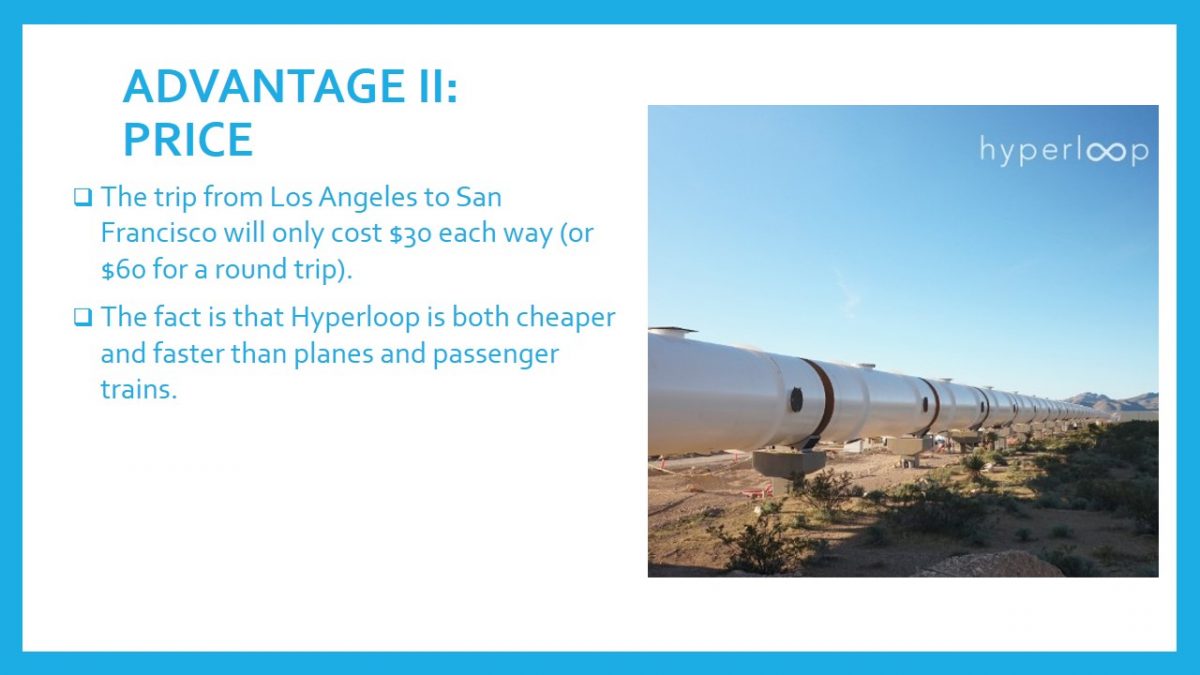
Transportation
- Hyperloop is an attempt to find a way to develop a means of transportation that is as similar to teleportation as possible.
- The fact of efficient transportation has become one of the major upsides to Hyperloop technology (including large-scale travel).
- The Hyperloop technology would only use 50 megajoules of energy to transfer passengers from Los Angeles to San Francisco.
Elon Musk himself has described the development of Hyperloop as an attempt to find a way to develop a means of transportation that is as similar to teleportation as possible. Therefore, supersonic travel has become the only option at this point in time; however, the only way to make this method of travel available is to place tubes under or on the ground within a certain environment. As a result, more efficient transportation has become one of the major upsides to Hyperloop technology (including large-scale travel). Musk’s proposition claimed that it would only require 50 megajoules of energy to transfer passengers from Los Angeles to San Francisco. All other types of transportation do not even come close to this result.
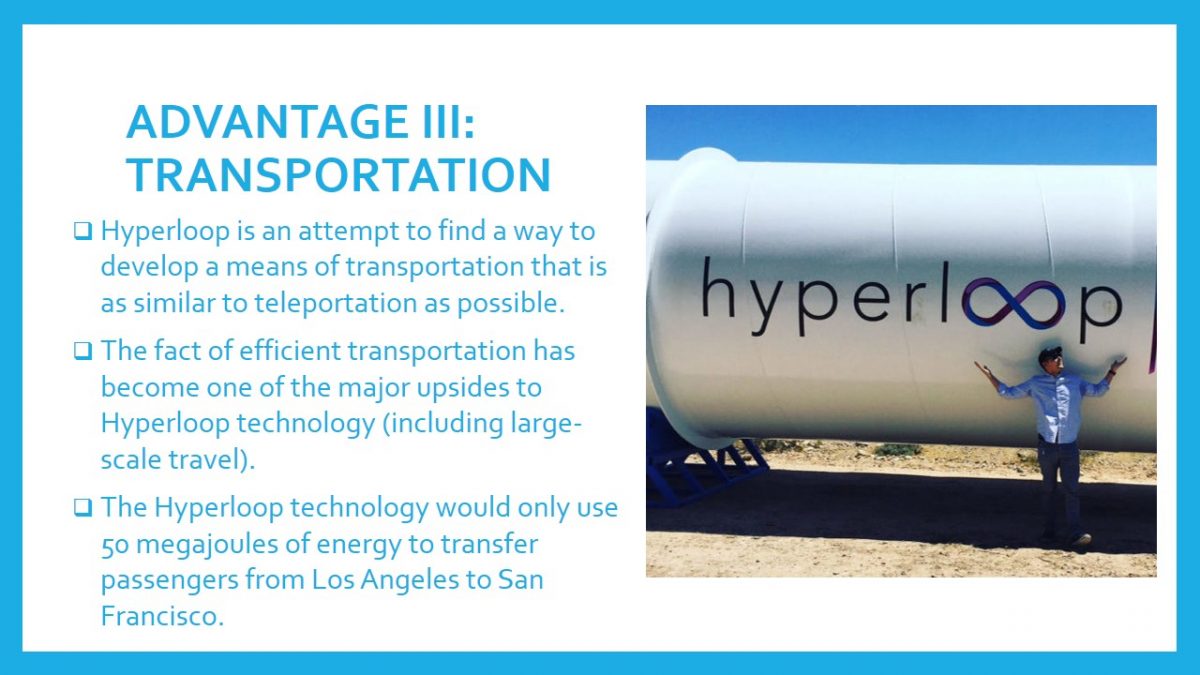
The Future
- People are willing and eager to make the dream of supersonic travel a reality.
- People are interested in investing in this new technology (Palacin 34).
- It will be a real shame if Hyperloop never goes live.
The last advantage of Hyperloop is its popularity. Many people are willing and eager to make the dream of supersonic travel a reality. Indeed, the efforts of Hyperloop developers have not gone unnoticed, as they have even organised a contest for the best Hyperloop design. Therefore, it is safe to say that Hyperloop will eventually become realized because a huge number of people are interested in investing in this technology (Palacin 34). The developers expect to expand Hyperloop to a national level and make it the fastest and cheapest among all means of transportation. Even the bullet train in California does not come close to what Hyperloop can do, so it will be a real shame if Hyperloop never goes live.
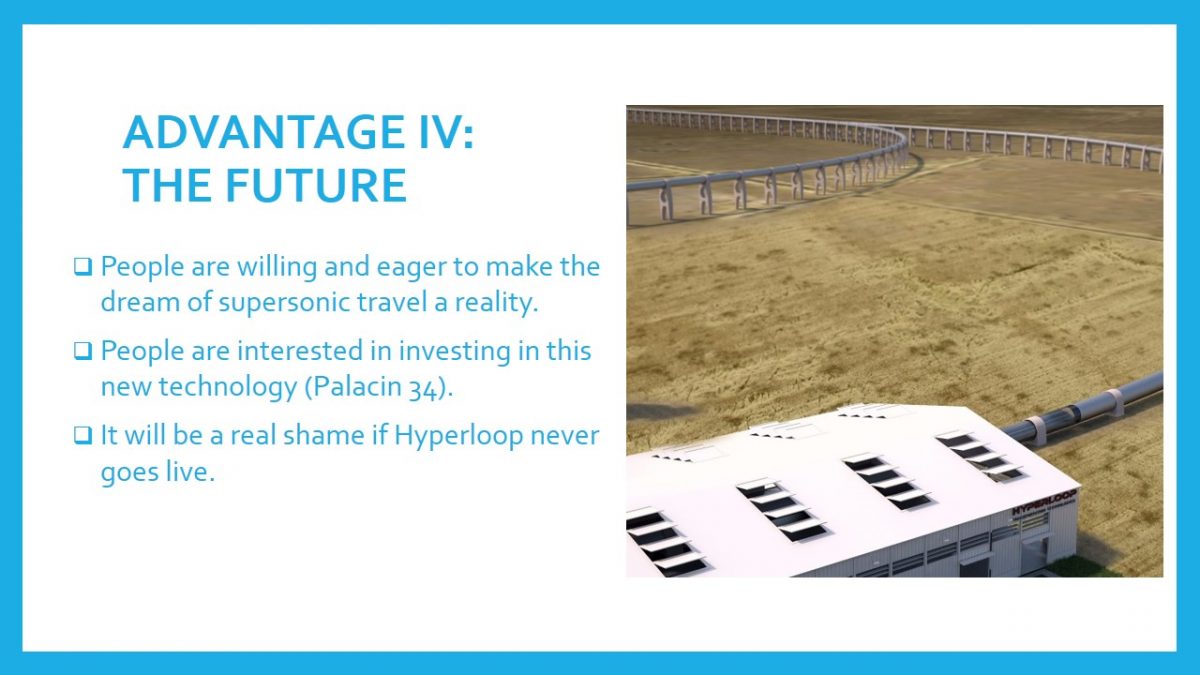
Key Issue
Land Rights
- The amount of ground work is going to be minimal.
- Hyperloop will have to interfere with both public and private lands.
- Court bills will reach a sky-high range of $5 to $6 billion.
Elon Musk believes that Interstate 5 could be one of the possible routes for the Hyperloop capsules. This road lies along a pretty straight passage, so there should be no problems with setting the tube to travel along the interstate on elevated pillars. As a result, the amount of ground work required is going to be minimal. Nonetheless, problems will arise when the interstate takes a turn but Hyperloop cannot. This layout, in fact, means that Hyperloop will have to interfere with both public and private lands, which is certainly not an ideal situation. Anyone whose land is about to be used by a rich engineer such as Elon Musk would be happy to demand a certain amount of money from Hyperloop. In perspective, this negotiating and purchasing may lead to a situation in which court bills reach a sky-high range of $5 to $6 billion (not even considering the fact that the same amount of money will be necessary to build Hyperloop itself).
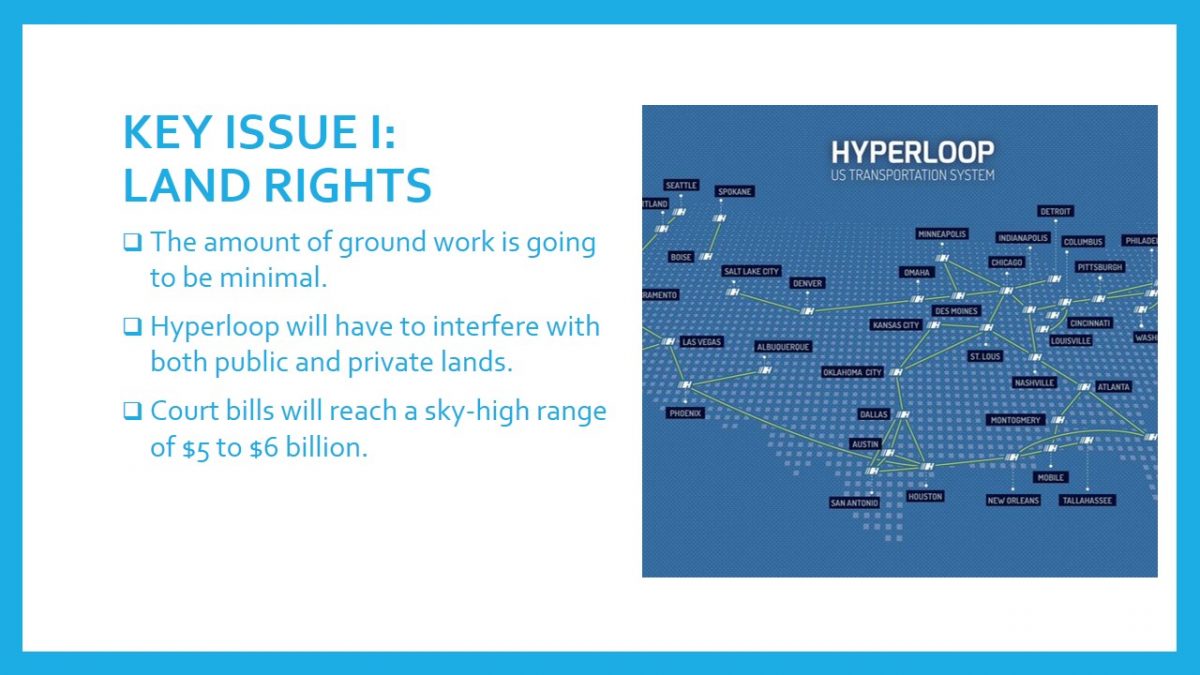
Eco-Friendliness?
- Disapproval is coming from those who want to preserve the environment and the greenery that will be cut in order to construct the Hyperloop pillars.
- The developers of Hyperloop have to consider all existing regulations.
- Some of the eco-friendly options include leather-less seats and specific battery composition methodology.
Even though Hyperloop has been described as a technology that works on solar power and does not have a negative impact on the environment (for instance, it does not emit any greenhouse gases and is silent), it has still received a great deal of criticism. Particularly, disapproval is coming from those who want to preserve the natural environment and the greenery that will have to be cut in order to construct the Hyperloop pillars. Legal battles are inevitable, and that is a fact. The most serious criticism, however, has come from environmental activists in California who believe that all technology negatively impacts the natural surroundings. Therefore, the developers of Hyperloop have to consider all the existing regulations and criticisms in order to come up with the most effective decisions regarding their technology (including, for example, leather-less seats and specific battery composition methodology).
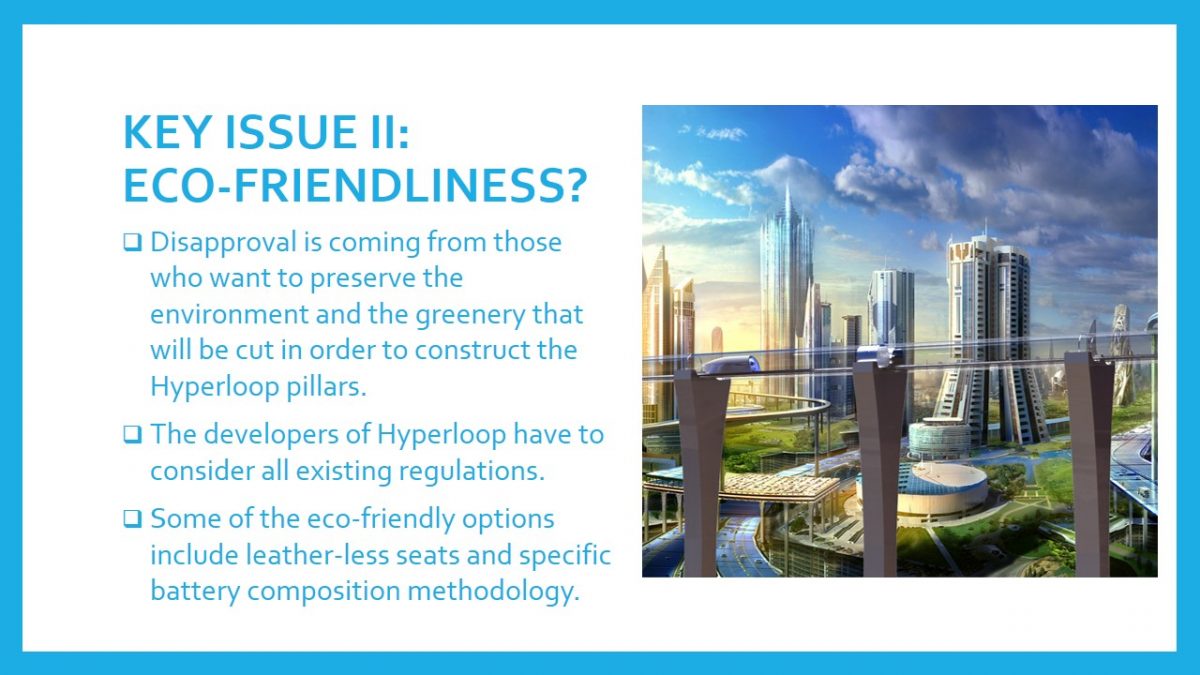
What If?
- Musk’s intentions are aimed at mitigating the adverse impact of natural calamities.
- It is rather scary to imagine what would happen if an earthquake were to shake the tubes with just enough power to destabilise them (Speed and Elledge).
Humans are no strangers to serious accidents, and transportation infrastructure is not an exception. We have witnessed trains that derail, planes that go down, and bridges that collapse for virtually no reason. Therefore, we should realise that most equipment tends to fail over time and consider the worst possible scenarios for Hyperloop. Musk’s intentions are aimed at mitigating the adverse impact of natural calamities such as earthquakes. Indeed, it is rather scary to imagine what would happen if one of the earthquakes were to shake the tubes with just enough power to destabilise them (Speed and Elledge). We can assume that nothing good would happen to capsules traveling at 700 mph, and the catastrophic outcomes are easily predictable.
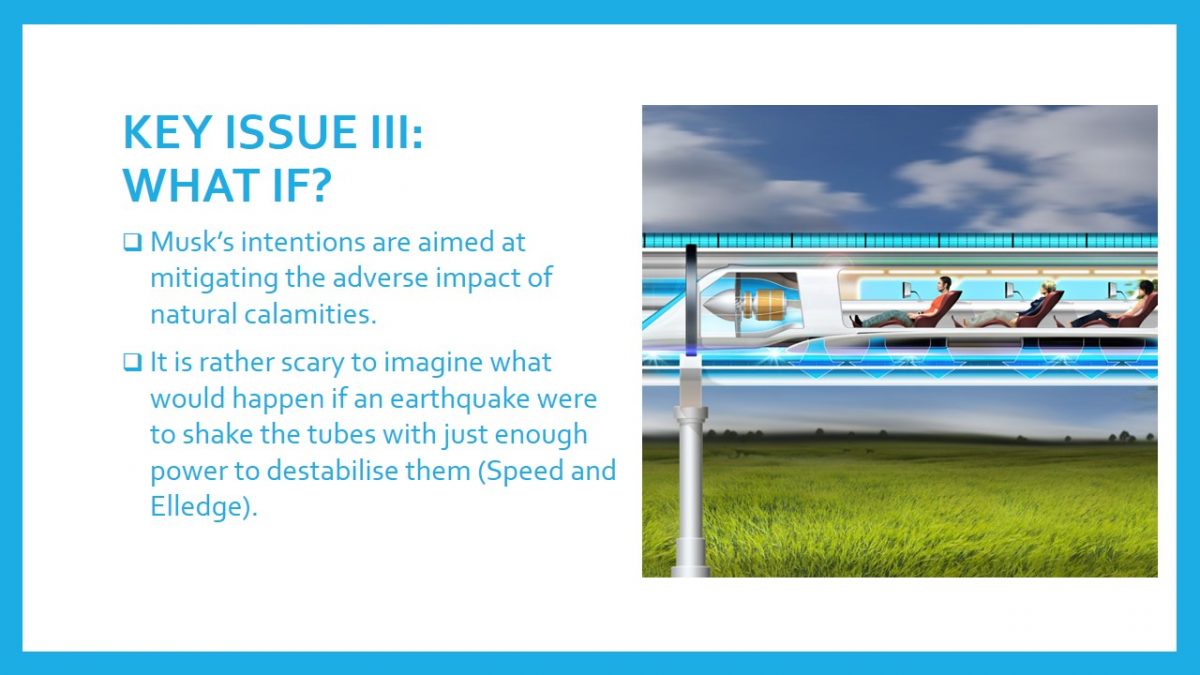
Not Enough Space
- How am I going to fit in there?
- Hyperloop developers will not be able to distract their passengers from the very limited legroom.
- There is no bathroom on board.
- This means of transportation is a bit extreme for the majority of people (Yarow).
One of the most common responses that one can hear when showing a picture of the Hyperloop interior is this: ‘How am I going to fit in there?’ The problem does exist, and it is not an exaggeration. Hyperloop developers will not be able to distract their passengers from the very limited legroom. Moreover, there is no bathroom because people are basically strapped to their seats for the full 30 to 40 minutes of their trip; they will not be able to get up and go anywhere. Despite the fact that the tickets are cheap, this means of transportation is a bit extreme for the majority of people, and it may seem that Musk will have to pay people first to get on the Hyperloop (Yarow). If the technology is seen as exciting but dangerous, it will actually kill all the promising hype around Hyperloop.

Innovation Option
More Space
- It is expected to raise the costs of capsules and tickets.
- Musk will have to deal with greater development and production costs.
- This seems to be a reasonable investment considering the popularity of Hyperloop and the human willingness to experience the excitement of traveling at hypersonic speeds.
The first innovation that is proposed is an extended space in the Hyperloop capsule. Even though it is expected to raise the costs of capsules and, probably, Hyperloop tickets as well, it is rather unlikely that the majority of people will sacrifice their comfort in the name of supersonic travel. This is why it is important to first create a comfortable means of transportation but make it faster than any other means of transportation currently available. Musk will have to deal with bigger development and production costs, but over a long-term timeframe, the extra space seems to be a reasonable investment (considering the popularity of Hyperloop and the human willingness to experience the excitement of traveling at hypersonic speeds).

Increased Safety
- The two key safety concerns revolve around emergency stops and the lack of oxygen.
- This two-part innovation includes a high-tech radar that would display all Hyperloops on the same map and show alerts in case something unexpected were to happen along the road.
- The key safety concern revolves around what to do in case the passengers become stuck in the vacuum-sealed tubes somewhere underground.
Another important innovation entails the increased safety of Hyperloop capsules. Regardless of the anti-earthquake measures that have been taken into consideration by Hyperloop developers, it is also crucial to emphasise other critical safety aspects. The two key safety concerns revolve around emergency stops and the lack of oxygen. This two-part innovation includes a high-tech radar that would display all Hyperloops on the same map and show alerts in case something unexpected were to happen along the way. The lack of oxygen will be mitigated by means of special oxygen masks that are similar to those that can be found on planes. Therefore, the key safety concern remaining revolves around what to do in case the passengers become stuck in the vacuum-sealed tubes somewhere underground.
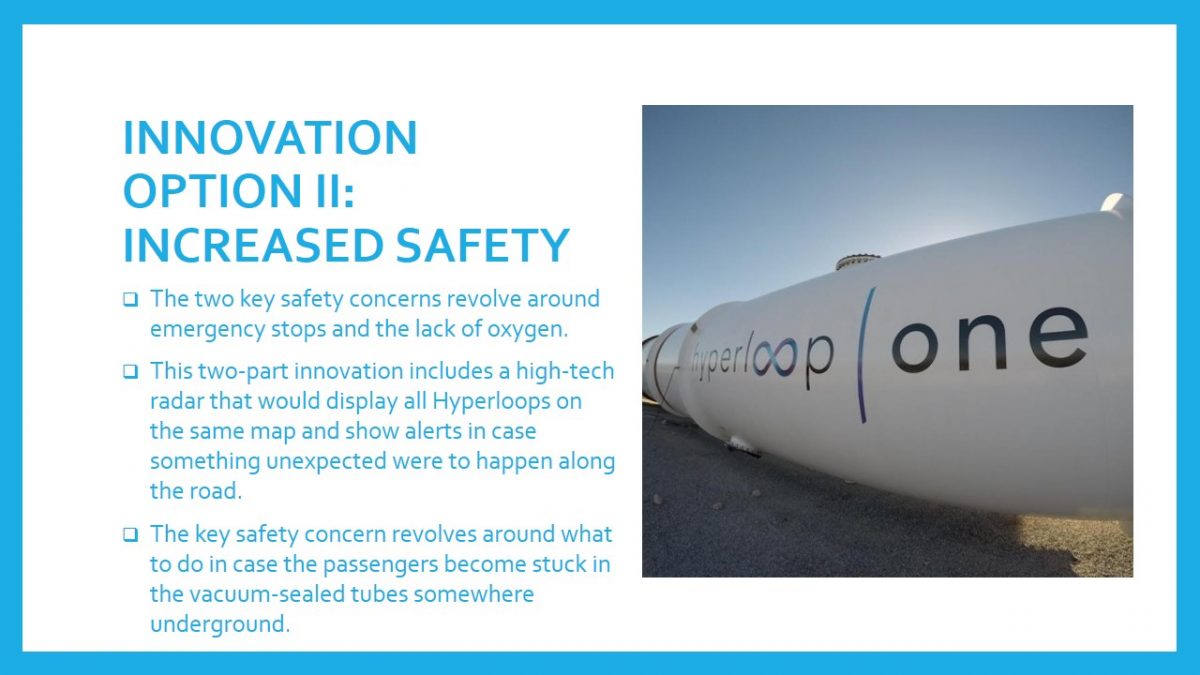
Specific Innovation Solution
- Based on the information presented above, the innovation that will be reviewed within the framework of this presentation is a GPS system that will be used to locate all active and inactive Hyperloops.
- These GPS systems will feature a minimap that will be used by the computer to locate other Hyperloop capsules and review decisions regarding the route and traveling speed in real time.
- This is necessary to prevent collisions or ineffective energy consumption.
- These roadmaps will be used by the computer-controlled capsules to estimate the necessary values regarding travel.
- The proposed minimap with all the necessary graphic representations (including stations, other Hyperloops, traveling speed, and much more) could also be transmitted to the monitors that are located right in front of the passengers.
- The key idea behind this placement is that the passengers will be aware of what is going on and will distract themselves from the travel.
- In addition to the monitors with the information, it may be interesting to introduce a sound system that would provide the passengers with audio notifications regarding upcoming stations or any other important information.
- The audio system may also be beneficial in terms of communicating the code of conduct to the passengers and explaining the Hyperloop’s safety engineering to them.
- In perspective, this system will reduce the impact of the human factor on the quality of Hyperloop technology and on overall passenger satisfaction.
- If Hyperloop developers decide to install monitors in the capsules and display all information that might be interesting to the passengers, they will be able to draw more customers to their product.
- This fact can be explained by the overall interest of the general public in Hyperloop and their willingness to invest in the development of this technology.
- If we combine ticket prices (probably even including the increases generated by the proposed improvements), traveling speed, and customer satisfaction, we will perhaps witness an ultimate means of transportation that comprises an eco-friendly and energy-saving approach while being cheap and fast at the same time.
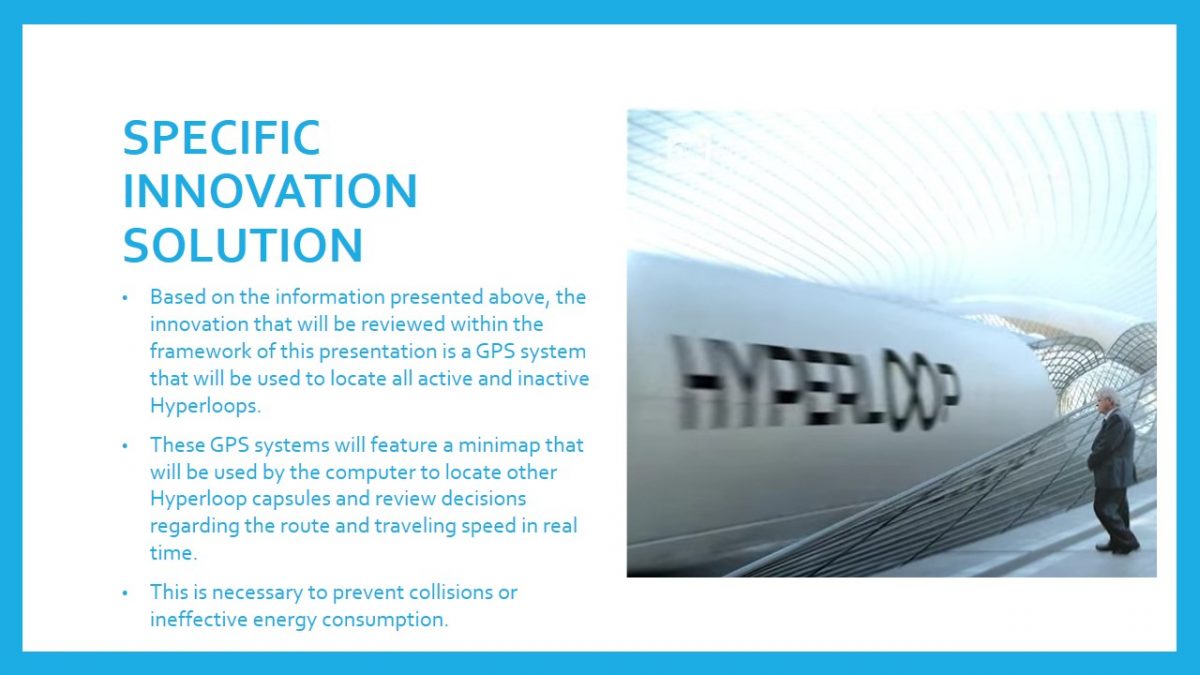
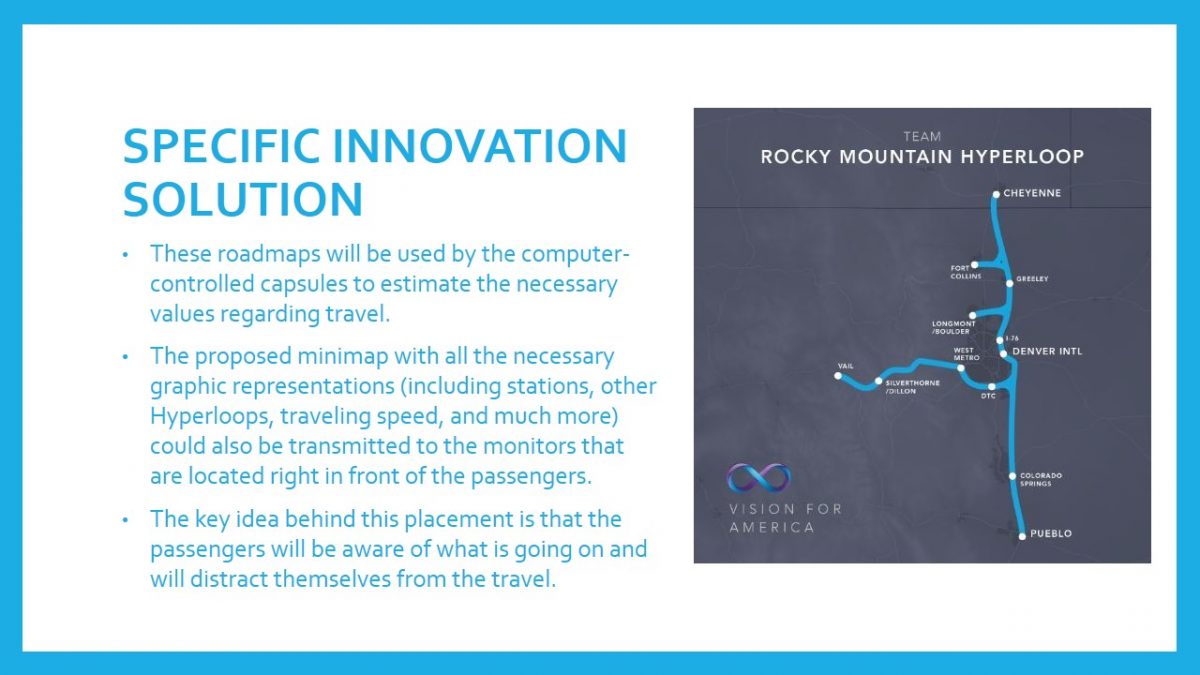
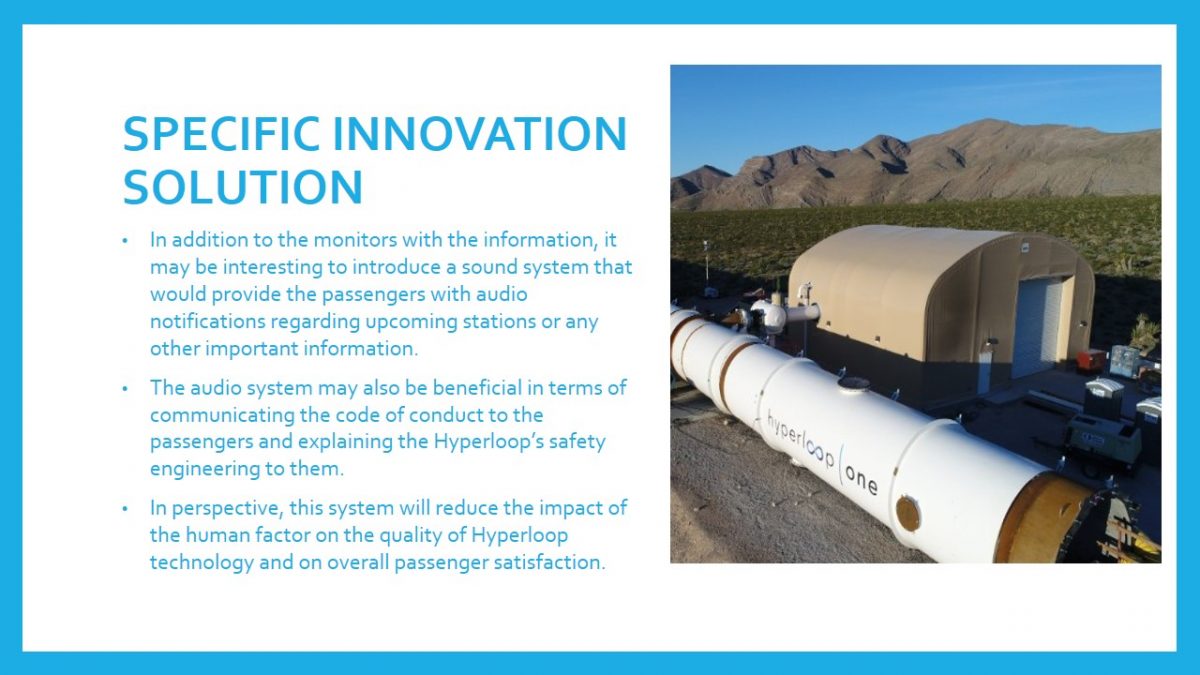
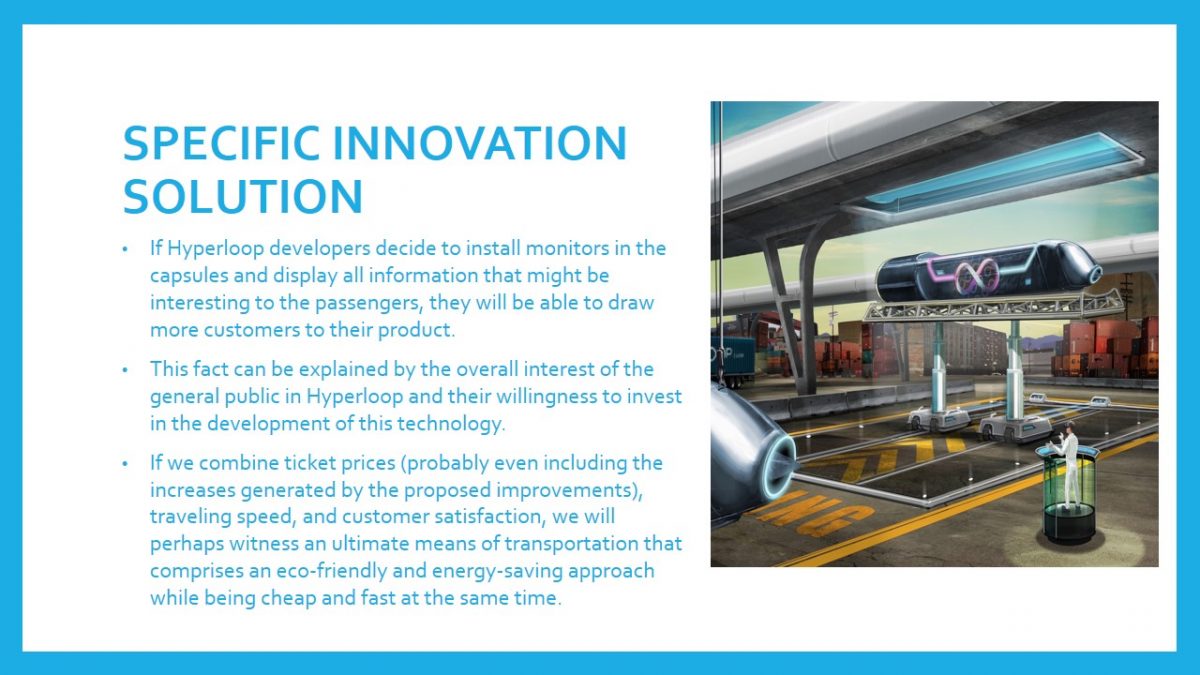
Conclusions and Recommendations
- This supersonic means of transportation was thoroughly tested in the state of Nevada.
- The Hyperloop development team is interested in collaborating with officials from Dubai because the Hyperloop team expects to expand their practice and test their innovative new transportation overseas.
- Almost 40 metropolitan areas have been identified by the Hyperloop team as possible cities to interconnect in the near future.
- Two recommendations include the following:
- Building a route from Las Vegas to Reno (in the state of Nevada);
- Launching a number of freight routes in order to test the eminence of the Hyperloop technology;
- Incomes are expected to grow, and the freight flow is also expected to increase significantly (Werner et al. 32).
- The importance of landscape and urban design should not be underestimated.
- One key recommendation is to build not through but around cities.
- Another key issue that should be reviewed by the Hyperloop development team is the incalculable number of complications that are associated with the process of urban planning.
- Hyperloop will be able to reach suburban populations.
- One should bear in mind that the majority of people are still ‘tied’ to their personal vehicles.
- The ultimate decision would be to build Hyperloop stations in suburban areas in order to minimise the technology’s carbon footprint on the environment.
- Hyperloop should be a technology that will provide humans with autonomous vehicles that will send passengers directly to their final destinations.
- Musk’s initiatives require governmental and industrial support.
Even though the concept of Hyperloop was originally met with a reasonable portion of scepticism, nowadays this technology is making news all over the world. The fact is that the technology of traveling via vacuum-sealed tubes has become a reality (yet, not so long ago). This supersonic means of transportation was thoroughly tested in the state of Nevada and allowed Elon Musk to take over the future market of supersonic transportation and become the lone leader in this race.
The engineers of this futuristic technology have paid special attention to testing the propulsion system. By the end of the year, the Hyperloop team expects to complete the full testing of its futuristic child. Moreover, they are interested in collaborating with officials from Dubai because the Hyperloop team expects to expand their practice and test their innovative transportation overseas. If the system’s safety gets verified, it will mean that soon we will see Hyperloop stations all across the United States.
Nonetheless, the future of Hyperloop is still unclear. Even the developers of this amazing technology are not yet sure where this journey will take them and how Hyperloop will end up. Almost 40 metropolitan areas have been identified by the Hyperloop team as possible cities to interconnect in the near future.
One of the recommendations would be to start by building a route from Las Vegas to Reno (in the state of Nevada) so as to connect one of the most popular cities in Nevada with the largest manufacturing centre of the latter. The Department of Transportation in Nevada would be interested in launching a number of freight routes in order to test the eminence of the Hyperloop technology.
If we take into consideration all the advantages of the supersonic Hyperloop, we will see that incomes are expected to grow and that the freight flow is also expected to increase significantly (Werner et al. 32). The only problem that should be solved by the Hyperloop developers is the size of the pillars because they are critical to the future shipping capabilities of Hyperloop. Moreover, by showcasing the freight option, the Hyperloop development team will be able to certify the safety of their innovative technology.
In perspective, Hyperloop capsules are expected to transport both human passengers and cargo freight. Nonetheless, one of the most critical tasks is not the reliability of Hyperloop but the problem of designing the routes. The importance of landscape and urban design should never be underestimated because this technology has to be designed in a way that benefits everyone.
Another recommendation that is relevant within the framework of the current discussion is to build not through but around the cities (especially the massive metropolitan areas). This recommendation has also been supported by numerous panellists who have reviewed the eminence of Hyperloop and have evaluated the proposals coming from the frontrunners of this innovative technology.
One of the key issues that should be reviewed by the Hyperloop development team is the incalculable number of complications that are connected to the process of urban planning. One of the most prevalent ideas revolves around the fact that Hyperloop should be peripheral, instead of piercing through the vital parts of the cities. This recommendation is also supported by the fact that when people travel, they usually travel from one peripheral area to another, rather than finding themselves in the very centre of a metropolitan area. By applying this particular approach, Hyperloop will be able to cover suburban populations who actually make up more than one half of the total population in the United States. Also, when discussing the process of implementing Hyperloop, one should bear in mind that the majority of people in the country are still ‘tied’ to their cars, a fact that adversely affects the mass transit sphere.
Therefore, the final decision should be to build Hyperloop stations in suburban areas in order to minimise the technology’s carbon footprint on the environment. On a bigger scale, we have to understand that even Hyperloop will not solve the problem of having to drive a car to and from the Hyperloop station. It is reasonable to view Hyperloop as a technology that will be able to provide humans with autonomous vehicles that will send passengers directly to their final destinations. By doing this, humanity will be able to solve the ‘last-mile problem’, allowing passengers to reach their destinations without changing back to the car at any point of the traveling process.
To conclude, the future of both autonomous vehicles and Hyperloop capsules is blurred, but the outlooks are rather promising overall. Despite the numerous barriers that may interfere with the implementation of this technology, many people support the development of these vehicles of the future. It is also safe to say that Musk’s initiatives require governmental and industrial support. A number of problems still have to be solved, but the issues that are inherent in the current business and industrial environment may become insurmountable.
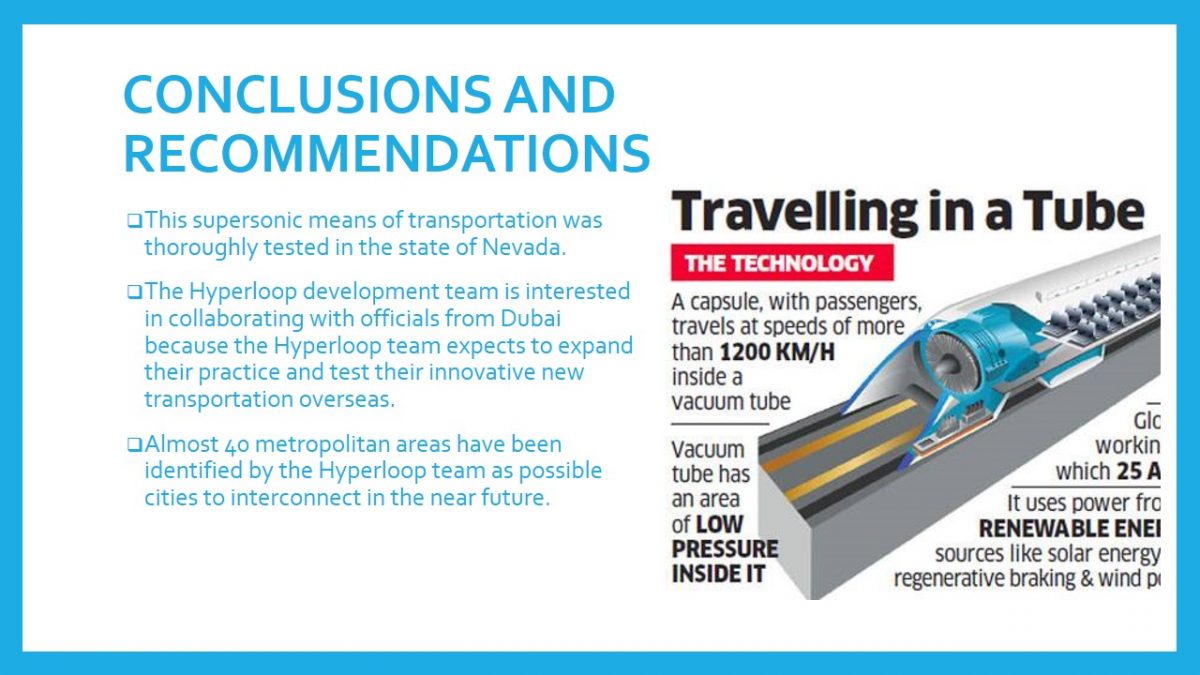



Works Cited
- Palacin, Roberto. “Hyperloop, the Electrification of Mobility, and the Future of Rail Travel.” IEEE Electrification Magazine, vol. 4, no. 3, 2016, pp. 4–51. Web.
- Ross, Philip E. “Hyperloop: No Pressure.” IEEE Spectrum, vol. 53, no. 1, 2016, pp. 51–54. Web.
- Speed, Barbara, and Jonn Elledge. “Elon Musk’s Hyperloop Might Actually Get Built.” CityMetric. 2015. Web.
- Vance, Ashlee. “Revealed: Elon Musk Explains the Hyperloop, the Solar-Powered High-Speed Future of Inter-City Transportation.” Bloomberg. 2013. Web.
- Werner, Max, et al. “Shared Value Potential of Transporting Cargo via Hyperloop.” Frontiers in Built Environment, vol. 2, 2016, pp. 3–35. Web.
- Yarow, Jay. “Elon Musk Reveals the Hyperloop.” Business Insider, Business Insider. 2013. Web.